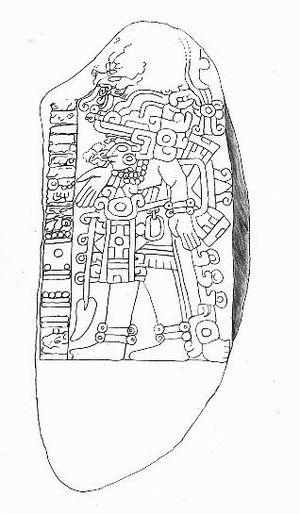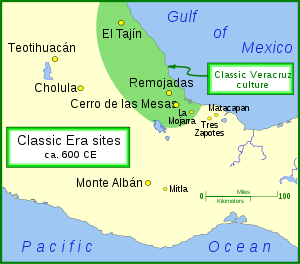
Cerro de las Mesas
Encyclopedia


Spanish language
Spanish , also known as Castilian , is a Romance language in the Ibero-Romance group that evolved from several languages and dialects in central-northern Iberia around the 9th century and gradually spread with the expansion of the Kingdom of Castile into central and southern Iberia during the...
, is an archaeological site
Archaeological site
An archaeological site is a place in which evidence of past activity is preserved , and which has been, or may be, investigated using the discipline of archaeology and represents a part of the archaeological record.Beyond this, the definition and geographical extent of a 'site' can vary widely,...
in the Mexican state of Veracruz
Veracruz
Veracruz, formally Veracruz de Ignacio de la Llave officially Estado Libre y Soberano de Veracruz de Ignacio de la Llave , is one of the 31 states that, along with the Federal District, comprise the 32 federative entities of Mexico. It is divided in 212 municipalities and its capital city is...
, in the Mixtequilla area of the Papaloapan River
Papaloapan River
The Papaloapan River is one of the main rivers of the Mexican state of Veracruz. Its name is derived from the Nahuatl papalotl and apan ....
basin. It was a prominent regional center from 600 BCE to 900 CE, and a regional capital from 300 CE to 600 CE.
Located about 50 km (31.1 mi) due south of Veracruz City, Cerro de las Mesas is on the west edge of what had been the Olmec heartland. Rising to prominence after the decline of the Olmec
Olmec
The Olmec were the first major Pre-Columbian civilization in Mexico. They lived in the tropical lowlands of south-central Mexico, in the modern-day states of Veracruz and Tabasco....
civilization's culture, some researchers consider Cerro de las Mesas, along with similar sites like La Mojarra
La Mojarra
La Mojarra is an archaeological site in the Mexican state of Veracruz, located not far from the Gulf Coast at a bend in the Acula River. It was continually occupied from the late Formative period until perhaps as late as 1000 CE....
and Tres Zapotes
Tres Zapotes
Tres Zapotes is a Mesoamerican archaeological site located in the south-central Gulf Lowlands of Mexico in the Papaloapan River plain. Tres Zapotes is sometimes referred to as the third major Olmec capital , although Tres Zapotes' Olmec phase constitutes only a portion of the site’s history, which...
, to be a center of epi-Olmec culture
Epi-Olmec culture
The Epi-Olmec culture was a cultural area in the central region of the present-day Mexican state of Veracruz, concentrated in the Papaloapan River basin, a culture that existed during the Late Formative period, from roughly 300 BCE to roughly 250 CE. Epi-Olmec was a successor culture to the Olmec,...
, a successor culture to the Olmecs, and one that itself gave way to Classic Veracruz culture
Classic Veracruz culture
Classic Veracruz culture refers to a cultural area in the north and central areas of the present-day Mexican state of Veracruz, a culture that existed from roughly 100 to 1000 CE, or during the Classic era....
in the 3rd century CE.
The site contains a man-made lagoon as well as hundreds of artificial mounds, usually in groups, often clustered with a long and a conical mound. These mound groups were likely built during the epi-Olmec period, 400 BCE to 300 CE. It was also during this period that the influence of Teotihuacan
Teotihuacan
Teotihuacan – also written Teotihuacán, with a Spanish orthographic accent on the last syllable – is an enormous archaeological site in the Basin of Mexico, just 30 miles northeast of Mexico City, containing some of the largest pyramidal structures built in the pre-Columbian Americas...
appears in the archaeological record
Archaeological record
The archaeological record is the body of physical evidence about the past. It is one of the most basic concepts in archaeology, the academic discipline concerned with documenting and interpreting the archaeological record....
.
Sometime later, during the Classic period
Mesoamerican chronology
Mesoamerican chronology divides the history of pre-Columbian Mesoamerica into several periods: the Paleo-Indian , the Archaic , the Preclassic , the Classic , and the Postclassic...
, a cache of some 800 jade items, some dating from Olmec civilization hundreds of years earlier, were buried at the base of the large mound of the central group.
Cerro de las Mesas is home to many stele
Stele
A stele , also stela , is a stone or wooden slab, generally taller than it is wide, erected for funerals or commemorative purposes, most usually decorated with the names and titles of the deceased or living — inscribed, carved in relief , or painted onto the slab...
— artistic stone slabs — several of which contain portrait carvings. Four of these stele — numbers 5, 6, 8, and 15 — contain what are likely to be pieces of Epi-Olmec or Isthmian script
Isthmian script
The Isthmian script is a very early Mesoamerican writing system in use in the area of the Isthmus of Tehuantepec from perhaps 500 BCE to 500 CE, although there is disagreement on these dates...
.

